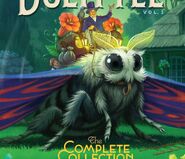The Giant Lunar Moth is a species of gigantic insects which inhabit the Earth's moon and grow to be as big as a house. They're most notable for having demonstrated the capacity to escape the atmosphere of their homeworld and fly straight to the Earth, although the voyage does take a heavy toll on their health and they may require days of rest and medical care afterwards.
Biology[]
Members of this species resemble huge moths, although of a species unheard of on Earth. Their bodies are black, but covered in light-brown hair, with red and blue patterns on their wings and green-colored legs. When at rest, their wings fold close to their bodies. Their eyes are described as being strange, but also beautiful. They act as pollinators to the giant flowers of the moon, and can also feed on Earth honey.
Like all lunar creatures, the Giant Moths are believed to be descendant from regular Earth moths which survived the planetary incident that caused a portion of the prehistoric Earth to be launched into space and become the moon. Thanks in great part to the moon having much more oxygen in its atmosphere and a weaker gravitational pull, the lunar creatures evolved to become bigger and phenomenally long-lived, with lifespans encompassing centuries, and in some cases millennia.
Culture and society[]
All plant and animal lifeforms on the moon are intelligent and they're all part of a great Council, containing representatives of all species (with the notable exception of the anti-social Moon Cats). The Council oversees that there is no conflict among the different species, for instance: dictating how many of each plant's seeds are to be allowed to grow and how many are to become food for the birds and insects. For this reason, the entire biosphere of the moon can be described as an example of mutualistic symbiosis.
Appearances[]
- Doctor Dolittle's Garden, by Hugh Lofting (1927)
- Doctor Dolittle in the Moon, by Hugh Lofting (1928)
- Doctor Dolittle's Return, by Hugh Lofting (1933) (Mentioned only)
- Doctor Dolittle, film (1967)
Gallery[]
Notes[]
- Unlike the novels, the 1967 film suggests that the Lunar Moth regularly performs the trip between the Earth and Luna; being attracted by the light of each world like a regular moth is attracted towards a light bulb.

